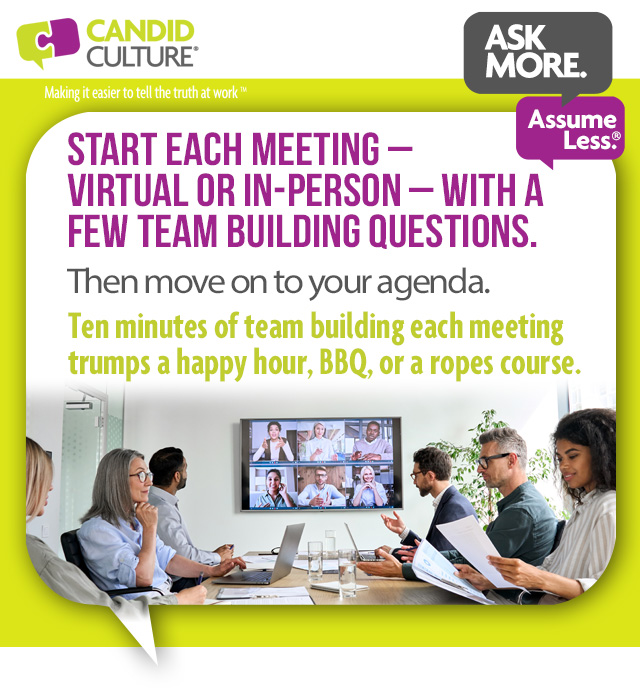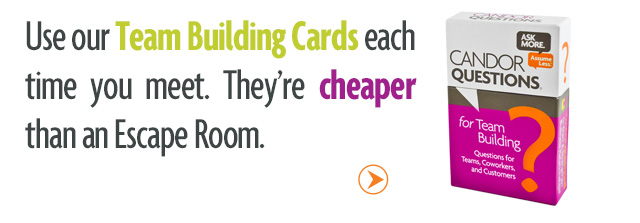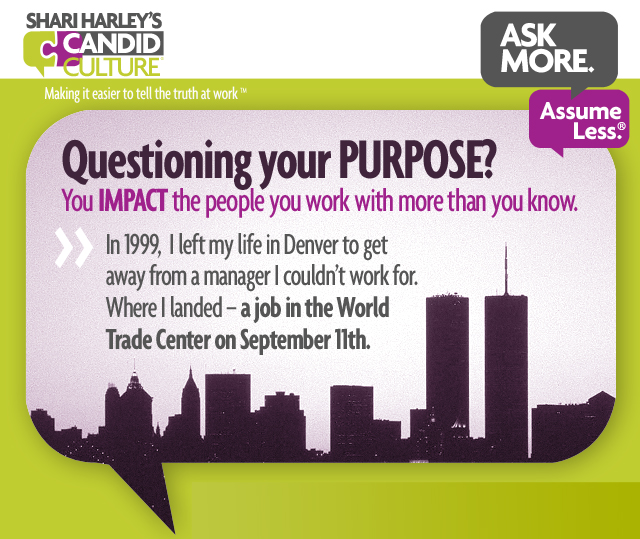Posts Tagged ‘workplace culture’
Leaders with virtual and hybrid workforces are worried about losing their organization’s culture. Some organizations are calling employees back into the office to retain culture. Others are hosting in-person social events, retreats, and meetings to help employees reconnect and strengthen culture.
Getting together in person is nice but it isn’t always possible. And what happens when everyone goes home? Culture is built on a daily basis.
Organizational culture is an outcome of the decisions we make and how those decisions get made, how we treat people, and how we communicate and work together. If you want to strengthen your organization’s culture, do it every day.

To strengthen your culture, take small regular actions.
Start each meeting helping employees get to know each other better, from a work perspective.
Host town halls at least twice a year.
Host roundtable discussions between senior leaders and a diverse sample of your workforce.
Have leaders and managers leave employees a weekly voicemail. Share a recent success, challenge, or goals. Keep messages short and authentic. Set the tone for the week.
All of these actions can be done virtually or in a hybrid setting.
Give employees opportunities to talk to each other about the things that matter most at work. Do this regularly – at least a few times a year.
You don’t need to spend a lot of money to strengthen and retain your culture. Go small, go cheap – regularly.


The inspiration for this week’s blog came from the most unlikely source, time with my son. I want each of his days to be exciting and fun. On the days we do nothing but hang out and play at home, I feel like I’ve failed just a little bit. It’s a lot of pressure. Not unlike work and creating an office culture.
I want each of my employees to be happy and to enjoy their jobs and enjoy working for me, every day. That can’t and won’t happen. Some days are hard. Some are dull. Sometimes I’m fun and easy to work for. Lots of days I’m not.
I had a manager years ago who told me that my need to be liked by my employees would take me down. He was right. Unfortunately, I’m not the only manager with this challenge.
Lots of managers tell me they’re hesitant to give feedback because they’re afraid employees will quit. Other managers do work they know they shouldn’t be doing, because they don’t want to burden their employees.
Not every day will be great. And that’s ok. Work is a roller coaster. Some days are awesome. Others are the pits. Your job isn’t to make people happy at every moment, it’s to create a supportive environment and ensure people have the tools to be successful.
My son has a clean and safe home full of fun toys. I’ve created a positive environment for him. My employees have all the tools they need to be successful. I work hard to set clear expectations and give timely positive and upgrade feedback. The rest is up to them. Some days I’m sure they’re happy. Most days, hopefully. And then I’m sure there are days that a job at Taco Bell sounds appealing.
Here are five actions to create a positive culture at work:
Office culture tip #1: Set clear expectations at the beginning of every new project and task. The root of frustration and unhappiness is thwarted expectations.
Office culture tip #2: Ask for and be open to feedback from your employees and coworkers. Ask for feedback regularly and work to respond with, “Thank you for telling me that.”
Office culture tip #3: Respond to feedback by changing what it makes sense to change. Giving feedback that is never acted upon creates cynicism and distrust.
Office culture tip #4: Provide rationale for your decisions. It’s fine to do things the way you want to do them, even if others disagree. Explain your rationale. You’ll get more buy in.
Office culture tip #5: Don’t be afraid to make decisions that are unpopular. There is a reason that you want to do what you want to do, the way you want to do it. Vet your plans, when appropriate. Be open to others’ input. And then do what you think is right (within the scope of your role).
Your job isn’t to please everyone and trying to do so will likely produce lesser results and be exhausting.






What to say about September 11th, this year, didn’t come to me until I was standing in front of a client’s leaders, talking with them about retaining employees and what they could do to become an even better place to work.
Their office isn’t too far from Shankesville, PA, where flight 93 crashed on September 11th, so they seemed like the right group with whom to share my story. Then I decided that perhaps I should share it with you too.
I bought my first house in Denver in 1999 and went on vacation shortly after closing on the house. Right before I left, my manager told me he had too many direct reports and was putting a layer between us. I’d have a new boss when I came back from my vacation.
Two weeks later, I returned to my new manager and found her to be defensive, paranoid, and irrational – in short, impossible to work with. I did everything I knew to work well with her, calling on our HR department and the EAP counseling available to me, for help. Despite that I led communication skills training for the company and taught conflict resolution, I couldn’t work with her, and let my old boss know I’d be leaving.
I suspect he already knew my new boss wasn’t going to work out (I wasn’t the only person struggling to work with her), and offered me a position in our New York office. He told me that if after 90-days I wanted to return to Denver, I could. Ninety-days in New York with all my expenses paid or unemployment with no plan? The choice was clear. I went to New York and moved into my office in Tower Two of the World Trade Center, where I worked on September 11th.
I’m not proud of uprooting my whole life for a manager I couldn’t work with, and it’s not something I recommend others do. But it does demonstrate the difference one person can make. I never actually lived in that first house I bought. I accepted a permanent job in New York, but wasn’t ready to let go of my life in Denver. So I struggled with the decision of whether to stay in New York or return to Denver, for three years.
It’s normal to question our purpose and wonder if we make a difference. If you ask these questions, consider all the people you work with on a daily basis and how you impact their daily lives. We spend a huge portion of our existence at work, and how we interact with coworkers, customers, direct reports, and vendors impacts their happiness, or lack thereof, in a big way.
Don’t underestimate the difference you make when you smile at someone in the hallway at work, or don’t. When you thank someone for making your job easier, or don’t. When you take the time to teach someone a quicker way to do something, saving him countless of hours, or don’t. Regardless of your title and position in your organization, you impact the people around you in a huge way, every day.
During last week’s training in Pennsylvania, I talked about the four things essential to retaining employees.
Retaining employees –the four things employees need to be satisfied and engaged at work:
- I trust the leaders who run this organization.
- My opinion means something. I am listened to.
- I feel respected (by my manager). We have a good working relationship.
- My work is challenging and interesting. My career is going somewhere here.
If you’re a manager working on retaining employees, spend time with your employees. Ask questions about their career goals. Take the time to coach and give feedback. If you’re a senior leader committed to retaining employees, be visible. Walk around your office(s), addressing employees by name, and asking about their daily work. And if you’re not in a position of leadership, be easy to work with by keeping your commitments, being a short cut and providing information when you can, and offering to help employees who are overwhelmed. Retaining employees is not just a manager’s job. Every person we work with impacts our daily lives more than we know.













